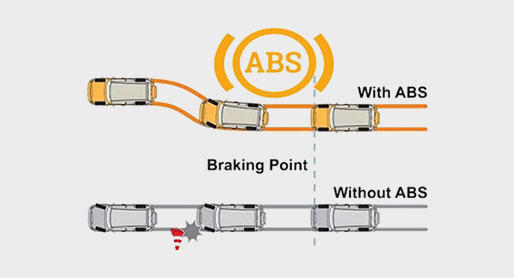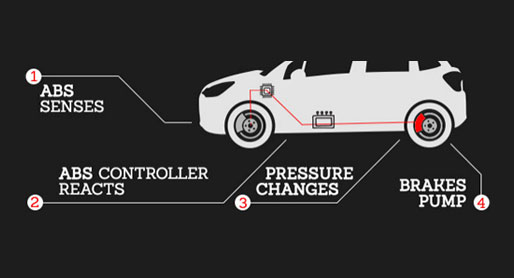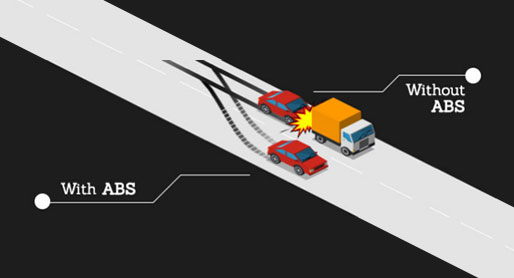Anti-Lock Braking System
What is Anti-Lock Braking System (ABS)?
The Anti-lock Braking System (ABS) is an important safety feature in automobiles that have been around for several decades now. Commonly known as ABS, or sometimes anti-skid braking systems, anti-lock braking systems help prevent car and motorcycle wheels from locking up and improve steering control whilst braking
ABS is designed to prevent the wheels of a vehicle from locking up during sudden or hard braking, which can lead to loss of control and accidents. It lets the user control or steer the vehicle while the brakes remain applied and also reduces the braking distance.
The first primitive form of ABS was developed in the 1920s by French pioneer Gabriel Voisin, initially to aid braking on aircraft. Although, it was not until the 1970s that ABS was adapted and introduced to the commercial vehicle market on a large scale.
Today, anti-lock braking is standard on virtually all new cars and motorcycles and used not only to aid steering whilst braking but also to help with traction control.
The four major components of a typical anti-lock braking system are:
- Speed sensors – These sensors monitor how fast the wheel or wheels are rotating
- Valves – Valves in the brake line allow block and release pressure on the brakes by assuming three different positions
- Pump – These pumps are filled with hydraulic fluid and apply pressure to the brake drums or callipers on demand
- Controller – The electronic control unit (ECU) is the brain of the ABS and uses data from the sensors to determine whether to pump the brakes
What is the need for ABS?
In standard braking (without ABS), when you press the brake pedal, the brake pads press tightly against the wheels’ discs to instantaneously stop the wheels’ rotation, causing them to lock up, regardless of what speed the vehicle is on.
When the wheels stop rotating, they can’t be steered, which means the driver loses all control over the wheels, and now the vehicle skids because of the momentum it is in. This can cause fatal accidents often.
How does the Anti-Lock Braking System work?
ABS works by releasing and then reapplying or pumping the brakes to a motorcycle wheel or car wheels in heavy braking situations. Sensors on each wheel are used to detect ‘locking’ or when a wheel stops moving and starts to skid. Although not all ABS systems are the same, with some only preventing wheels on the rear axle from locking up. When a lock-up is detected, ABS pumps the brakes, 100s of times a second. This stops the wheel or wheels from skidding and helps keep the driver in control of the vehicle. So essentially, ABS works in three stages:
- The brake pedal is pushed
- Wheel sensors detect skidding or ‘locking’
- ABS pumps the brakes



Advantages of ABS:
Prevention of Skidding and Loss of Control: One of the most important functions of ABS in automobiles is the prevention of skidding and loss of control. When a driver slams on the brakes in an emergency, the wheels of the vehicle can lock up and cause the vehicle to skid. This can make it difficult for the driver to steer the vehicle and maintain control, which can lead to an accident. ABS prevents this by modulating the brake pressure to each wheel, allowing the driver to steer the vehicle while braking.
Shorter Stopping Distance:ABS can also reduce the stopping distance of a vehicle in emergencies. When the wheels of a vehicle lock up during hard braking, the vehicle’s tires lose traction with the road, and it takes longer to come to a stop. ABS helps to maintain traction by preventing the wheels from locking up, which reduces the stopping distance and helps the vehicle to come to a stop more quickly.
Improved Stability and Handling: Another benefit of ABS is improved stability and handling. By preventing the wheels from locking up, ABS helps to maintain the stability of the vehicle during hard braking. This can be especially important in wet or slippery conditions where the tires have less traction with the road. ABS can also improve handling by allowing the driver to maintain control of the vehicle during sudden manoeuvres.
Enhanced Safety for All Passengers: ABS can provide enhanced safety for all passengers in a vehicle. By preventing skidding and loss of control, ABS can reduce the risk of accidents and injuries. This is particularly important in situations where there are multiple passengers in the vehicle. In the event of an accident, ABS can help to prevent the vehicle from spinning out of control and can help to keep passengers safe.
Better Control for the Driver: ABS can provide better control for the driver during emergencies. When the wheels of a vehicle lock up during hard braking, the driver can lose control of the vehicle, making it difficult to steer and manoeuvre. ABS helps to prevent this by modulating the brake pressure to each wheel, allowing the driver to steer the vehicle while braking.
In conclusion, the Anti-lock Braking System (ABS) is an important safety feature in automobiles that can save lives on the road. ABS prevents skidding and loss of control, reduces the stopping distance, improves stability and handling, provides enhanced safety for all passengers, and offers better control for the driver. Automobile manufacturers need to include ABS in all new vehicles to ensure the safety of drivers and passengers. Additionally, it is important for drivers to understand the benefits of ABS and to use it properly in emergencies. By doing so, we can help to reduce the number of accidents on the road and keep ourselves and others safe.
